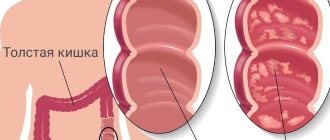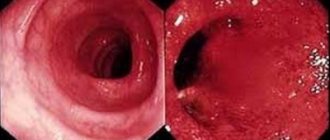1.What are the specifics of radiation colitis?
Colitis is a pathology of the large intestine of inflammatory origin. Inflammation of the mucous membrane most often develops gradually under the influence of a constant unfavorable background (reduced immunity, chronic diseases, stress) or systematic negative effects (for example, due to dietary errors).
In the case of radiation colitis, the pathogenetic factor is ionizing radiation. Most often, the disease becomes a consequence of radiation therapy carried out to treat tumor diseases of the pelvis. The combination of radiation exposure with chemotherapy drugs further increases the risk of developing radiation colitis. The radiation dose capable of causing radiation damage to the intestine exceeds 40 gray.
The specificity of radiation colitis is that the pathology may appear delayed - within two years after undergoing an intensive course of radiation therapy. Such patients are closely monitored by a gastroenterologist during this period. The slightest signs of colitis require careful examination and timely adequate therapy.
According to the nature of the course, radiation colitis is classified into:
- acute defeat;
- subacute course;
- chronic colitis.
A must read! Help with treatment and hospitalization!
Types of colitis: what are they?
- Ulcerative colitis. (Nonspecific ulcerative colitis, Crohn's disease). When it appears, ulcers form on the mucous membrane of the small intestine.
- Alimentary colitis. The most common type of colitis, which appears if the patient eats improperly and drinks alcohol in large quantities.
- Infectious colitis (Dysentery, eschirichiosis), which appears when the intestinal mucosa is exposed to pathogenic microbes.
- Spastic colitis. It occurs as a result of prolonged stress and anxiety - more often in people with a labile nervous system.
- Melancholy colitis. This is damage to the intestinal mucosa by chemicals, poisons and aggressive drugs.
- Allergic colitis. It is typical for people with allergies, so it can appear during allergic exacerbations.
- Mechanical colitis. This is damage to the epithelium of the colon when rectal suppositories, enemas and foreign objects are introduced into the anus.
- Ischemic colitis. Develops against the background of thrombosis of mesenteric vessels;
- Radiation colitis. It manifests itself when a person has been exposed to radiation.
2. Symptoms of radiation colitis
Radiation colitis begins like many other inflammatory diseases of the large intestine. The clinical picture unfolds gradually, starting with minor discomfort in the digestive system. Over time, symptoms increase and acquire typical signs of colitis:
- cramping abdominal pain;
- sudden strong urge to defecate;
- diarrhea;
- fragments of blood and mucus in the stool;
- constipation;
- the urge to defecate in the absence of feces (tanesma).
Radiation colitis, which develops directly during a course of radiation or immediately after receiving high doses of radiation, can be very severe, accompanied by intestinal bleeding, dehydration and ulceration in the intestine. This condition requires emergency care.
Visit our Gastroenterology page
Publications in the media
Radiation sickness (RS) is a disease caused by exposure of the body to ionizing radiation in doses exceeding the maximum permissible.
Etiology • Use of nuclear weapons (including testing) • Accidents in industry and nuclear energy • Eating radioactively contaminated foods (internal exposure) • Radiation therapy • Chronic LB - employees of the departments of radiation diagnostics and therapy.
Pathomorphology • Bone marrow - reduced cell content • Necrosis of the intestinal epithelium • Fibrosis of organs long after irradiation as a result of activation of fibroblasts.
Terminology • The concept of “radiation” includes: •• a-Particles - the nuclei of helium atoms. The penetrating power is minimal •• b-Particles are electrons. They have a low damaging effect when exposed to external influences (low penetrating ability), the most dangerous when ingested into the body (the so-called internal irradiation) •• g-Radiation - a flux of photons that occurs when the energy state of atomic nuclei changes, has a pronounced penetrating ability • Indicators of radiation exposure •• 1 Rad - absorption of 100 ergs of energy by biological tissue weighing 1 g •• 1 Roentgen (R) - dose unit of x-ray and g-radiation: with a dose of 1 R in 1 ml of air, such a number of positive and negative ions are formed that their charge equal to 1 electrostatic unit in the CGS system (each sign) •• 1 Gray (Gy) = 100 rad •• Rem ( biological equivalent of rad ) - unit of equivalent dose of ionizing radiation; 1 rem is taken to be the absorbed dose of any type of ionizing radiation that, during chronic irradiation, causes the same biological effect as an absorbed dose of X-ray or g-radiation of 1 rad; 1 rem = 0.01 J/kg •• 1 sievert (Sv) = 100 rem.
Classification
• Acute LB. Symptoms develop within 24 hours after exposure. The severity and clinical picture depend on the radiation dose •• When exposed to a dose of less than 100 rad, radiation injury is possible; the changes are reversible •• When irradiated with a dose of 100–1,000 rad, the bone marrow form of LB develops. Degrees of severity: ••• I - dose 100-200 rad ••• II - dose 200-400 rad ••• III - dose 400-600 rad ••• IV - dose 600-1000 rad •• When irradiated with a dose of 1,000 –5,000 rads, a gastrointestinal variant of acute LB develops, accompanied by severe gastrointestinal bleeding. Disturbances of hematopoiesis are significantly delayed •• When irradiated with a dose of more than 5,000 rad, a neurovascular variant of LB develops, characterized by the occurrence of cerebral edema and decerebration.
• Chronic LB occurs as a result of long-term, repeated exposure to ionizing radiation in relatively low doses. The probability of detecting a remote genetic or somatic effect of radiation is 10–2 per 1 Gy.
Clinical picture (other things being equal, irradiation conditions, clinical manifestations are more pronounced in young men)
• LB syndromes •• Hematological ••• Reactive leukocytosis in the first day after irradiation is replaced by leukopenia. In the leukocyte formula - a shift to the left, relative lymphopenia, from the 2nd day after irradiation absolute lymphopenia (can persist throughout life). The degree of lymphopenia has prognostic significance (more than 1.5´109/l - normal content; more than 1´109/l - survival is possible without treatment; 0.5–1´109/l - survival is possible with long-term conservative treatment; 0.1 –0.4´109/l - bone marrow transplantation is required; less than 0.1´109/l - high probability of death.) ••• Granulocytopenia develops 2-3 weeks after irradiation and resolves faster the earlier it is detected (on average - 12 weeks). Recovery from granulocytopenia is rapid (1–3 days), no relapses are noted ••• Anemia. When leukopoiesis is restored, a reticulocyte crisis is possible, but restoration of the level of erythrocytes occurs much later than that of leukocytes ••• Thrombocytopenia occurs when irradiated with a dose of more than 200 rad no earlier than the end of the first week after irradiation. The restoration of the platelet count is often 1–2 days ahead of the restoration of the leukocyte count. •• Hemorrhagic syndrome is caused by deep thrombocytopenia (less than 50´109/l), as well as changes in the functional properties of platelets •• Skin ••• Hair loss, primarily on the head. Hair restoration occurs within 2 weeks if the radiation dose is not higher than 700 rad ••• Radiation dermatitis: the most sensitive skin is the armpits, inguinal folds, elbows, and neck. Forms of damage: primary erythema develops at a dose above 800 rads, is replaced by swelling of the skin, and at doses above 2,500 rads, after 1 week it turns into necrosis or is accompanied by the formation of blisters; Secondary erythema occurs some time after primary erythema, and the shorter the period of appearance, the higher the radiation dose. Peeling of the skin, slight atrophy, and pigmentation are possible in the absence of a violation of the integrity of the integument, if the radiation dose does not exceed 1,600 rad. At higher doses, swelling and blisters appear. If the skin vessels are intact, secondary erythema ends with the development of pigmentation with compaction of the subcutaneous tissue, but subsequently, cancerous degeneration of the scars formed at the site of the blisters is possible. When skin vessels are damaged, radiation ulcers develop •• Damage to the oral mucosa - with a dose above 500 rads occurs on days 3–4. Swelling of the mucous membrane appears, dry mouth, saliva becomes viscous, causing vomiting. Ulcerative stomatitis is observed when the oral mucosa is irradiated at a dose above 1,000 rad, its duration is 1–1.5 months. Against the background of leukopenia, secondary infection of the mucous membranes is possible. Starting from 2 weeks, dense white plaques form on the gums - hyperkeratosis. Unlike thrush, plaque in hyperkeratosis cannot be removed with a spatula; there is no fungal mycelium in the smears •• Damage to the gastrointestinal tract - with external uniform irradiation with a dose of over 300–500 rad or with internal irradiation ••• Radiation gastritis - nausea, vomiting, pain in the epigastric region ••• Radiation enteritis - abdominal pain, diarrhea ••• Radiation colitis - tenesmus, blood in the stool ••• Radiation hepatitis - moderate cholestatic syndrome, cytolysis. The course is undulating for several months, progression to liver cirrhosis is possible •• Damage to the endocrine system ••• Strengthening the functions of the pituitary-adrenal system in the early stages as part of a stress reaction ••• Inhibition of the functions of the thyroid glands, especially with internal irradiation with radioactive iodine. Possible malignancy ••• Inhibition of the functions of the gonads •• Damage to the nervous system ••• Psychomotor agitation as part of the primary reaction ••• Diffuse inhibition of the cerebral cortex replaces psychomotor agitation ••• Disruption of the nervous regulation of internal organs, autonomic dysfunction ••• With neurovascular syndrome (irradiation with a dose of more than 5,000 rad) - tremor, ataxia, vomiting, arterial hypotension, convulsive attacks. Lethal outcome in 100% of cases.
• Periods of acute LB •• Primary radiation reaction begins immediately after irradiation, lasts several hours or days ••• Nausea, vomiting ••• Excited or lethargic state ••• Headache •• The period of imaginary well-being lasts from several days to a month (than the lower the dose, the longer it is; at a dose over 400 rads do not occur at all), is characterized by subjective well-being, although functional and structural changes in tissues continue to develop •• The peak period is 3–4 weeks, the above clinical syndromes develop •• The recovery period - duration of several weeks or months (the higher the radiation dose, the longer it is). A favorable prognostic sign is positive dynamics of lymphocyte content.
• Features of acute LB with uneven irradiation •• The period of imaginary well-being is shortened •• The clinic of the peak period is determined by the functional significance of the body area that received the maximum radiation dose. Hematological syndrome may recede into the background, giving way to manifestations of damage to the gastrointestinal tract or nervous system.
• Features of acute LB from internal irradiation •• The primary reaction is erased •• The period of imaginary well-being is short •• The peak period is long, has a wave-like course ••• Hemorrhagic syndrome occurs rarely ••• Skin damage is rare ••• Damage to the mucous membranes of the gastrointestinal tract is often observed ••• Accumulation in tissues depends on the type of radioactive element: lanthanum, cerium, actinium, thorium accumulate in the liver, radioactive iodine in the thyroid gland, strontium, uranium, radium, plutonium in the bones •• The recovery period is long.
• Periods of chronic LB •• Formation period. Among the LB syndromes, the most common are ••• Hematological syndrome (thrombocytopenia, leukopenia, lymphopenia) ••• Asthenovegetative syndrome ••• Trophic disorders: brittle nails, dry skin, hair loss •• The recovery period is possible only if exposure to radiation is stopped •• Period long-term consequences and complications ••• Acceleration of aging processes: atherosclerosis, cataracts, early decline of the functions of the gonads ••• Progression of chronic diseases of internal organs that occurred latently during the period of formation (chronic bronchitis, cirrhosis of the liver, etc.).
Laboratory tests • CBC: Hb, content of erythrocytes, leukocytes, lymphocytes, granulocytes • Feces for occult blood • Analysis of bone marrow aspirate • Microscopy of scrapings from the oral mucosa • Bacteriological blood cultures for sterility - in case of fever.
Special studies • Dosimetric monitoring • Neurological examination.
TREATMENT
General tactics • For acute LB •• Bed rest •• For the prevention of exogenous infections, patients are treated under aseptic conditions (boxes, air sterilization using UV rays) •• Diet: fasting and drinking water - for necrotizing enterocolitis •• Decontamination (surface treatment skin, gastric and intestinal lavage during internal irradiation) •• Detoxification ••• Intravenous infusions of hemodesis, saline solutions, plasma substitutes ••• Forced diuresis •• Antiemetics •• Blood transfusions ••• Platelet suspension for thrombocytopenia ••• Erythrocyte mass with anemia. When Hb >83 g/l without signs of acute blood loss, red blood cell transfusion is not recommended, because this can further aggravate radiation damage to the liver, enhance fibrinolysis • In acute LB due to internal irradiation •• Drugs that displace radioactive substances ••• In case of infection with radioactive iodine - potassium iodide ••• In case of infection with radioactive phosphorus - magnesium sulfate ••• In case of infection isotopes that accumulate in bone tissue - calcium salts •• Mild laxatives to accelerate the passage of radioactive substances through the gastrointestinal tract • For chronic LB - replacement and antibacterial therapy, as with other types of LB.
Drug therapy • Antiemetics: atropine (0.75–1 ml 0.1% solution) subcutaneously • Antibiotics •• To suppress the proliferation of microorganisms that normally live in the small intestine, with gastrointestinal syndrome ••• Kanamycin 2 g/day orally ••• Polymyxin B up to 1 g/day ••• Nystatin 10–20 million units/day ••• Co-trimaxozole 1 tablet 3 times a day ••• Ciprofloxacin 0.5 g 2 times a day •• For the treatment of fever due to neutropenia ••• The most optimal combination is aminoglycosides (gentamicin 1–1.7 mg/kg every 8 hours) and penicillins active against Pseudomonas aeruginosa (for example, azlocillin 250 mg /kg/day) ••• If fever persists for more than 3 days, first generation cephalosporins are added to the specified combination ••• If fever persists for 5-6 days, antifungal agents are additionally prescribed (amphotericin B 0.7 mg/kg/day).
Surgical treatment • It is necessary to carry out primary surgical treatment of wounds before decontamination • All surgical interventions for combined lesions are carried out within the first 2 days to prevent leukopenia and platelet dysfunction • Bone marrow transplantation - in case of its aplasia, confirmed by the results of bone marrow puncture.
Complications • Long-term fibrosis of the kidneys, liver and lungs - after irradiation with a dose of over 300 rad • Malignant neoplasms of various locations • Increased risk of leukemia (more often - acute lymphocytic, chronic myeloid leukemia) • Infertility.
Course and prognosis • Patients who survive 12 weeks have a favorable prognosis, but observation is necessary to exclude long-term complications • Complete recovery from chronic LB is impossible • When planning a family, medical genetic consultation is important.
Pregnancy. Even the lowest doses of radiation have a damaging effect on the fetus.
Prevention • Personal protective equipment (gas masks) • Mass protective equipment (shelters) • Increasing the reliability of industrial production associated with the use of radioactive substances.
Reduction. RB - radiation sickness
ICD-10. • D61.2 Aplastic anemia caused by other external agents • J70.0 Acute pulmonary manifestations caused by radiation • J70.1 Chronic and other pulmonary manifestations caused by radiation • K52.0 Radiation gastroenteritis and colitis • K62.7 Radiation proctitis • M96. 2 Post-radiation kyphosis • M96.5 Post-radiation scoliosis • L58 Radiation [radiation] dermatitis • L59 Other diseases of the skin and subcutaneous tissue associated with radiation • T66 Unspecified effects of radiation
Notes • Acute radiation syndrome occurred in 120,000 people in Japan as a result of nuclear explosions • The Chernobyl accident in 1986 resulted in approximately 50,000 people being exposed to radiation.
3. Diagnosis of radiation colitis
The diagnosis of colitis itself is not difficult. If there is information about the radiation received, it is assumed that it was the cause of the disease. However, even in this case, it is necessary to find out other possible factors in the development of pathology. Depending on the genesis, treatment regimens can vary significantly.
After collecting anamnesis and studying the patient’s complaints, a physical examination is performed and tests (blood, stool) are prescribed. The most informative diagnostic technique for suspected radiation colitis is endoscopy.
To confirm the diagnosis, endoscopic examination reveals:
- hyperemia of the colon mucosa;
- bleeding of the inner surface;
- erosive-desquamative changes;
- areas of purulent-necrotic lesions of deeper intestinal tissues.
If there is a suspicion of the presence of fistulas and cicatricial stenosis of the intestine, an additional X-ray examination is prescribed.
About our clinic Chistye Prudy metro station Medintercom page!
4. Treatment of radiation colitis and possible complications
Radiation damage to the intestines and its consequences are treated according to a regimen that is developed by a gastroenterologist after a thorough diagnosis. Depending on the severity of the pathology, the area of the lesion, and the dynamics, treatment includes measures aimed at restoring the colon mucosa and its functions. Treatment tactics may include:
- drug therapy (anti-inflammatory drugs, immunomodulators, probiotics, drugs for the prevention of anemia, vitamin B12);
- argon plasma coagulation (cauterization with argon to prevent bleeding);
- treatment with oxygen (hyperbaric oxygenation);
- surgical treatment (for strictures and adhesions in the intestinal lumen).
Treatment of radiation colitis is always covered with a strict diet, excluding spicy, fatty, fried, and salty foods. The following products are also not recommended:
- milk and dairy products;
- nuts;
- chocolate, coffee, cocoa;
- alcohol.
Vegetables and fruits should be stewed or baked, boiled lean meat, juices should be consumed in the form of jelly. Food must be chewed thoroughly. The most beneficial is fractional nutrition; each portion should include well-combined foods.
Often with acute radiation colitis it is necessary to reduce physical activity, especially if there is a risk of bleeding. Stressful situations and heavy lifting should be avoided. If you feel tired, rest is necessary, and at night - a full 8-hour sleep.
If treatment is untimely or inadequate, chronic radiation colitis causes severe complications (necrotic intestinal damage, fibrosis, stenosing endarteritis).
Treatment of colitis at the Central Clinic of the Bibirevo district
Diet is the main rule that patients should remember if they have colitis. Without compliance, treatment will not bring proper results. Fatty and spicy foods may resist treatment because they greatly irritate the intestinal mucosa. When treating Crohn's disease, patients are also prescribed anti-inflammatory medications. If they do not bring the expected effect, the doctor prescribes drugs that affect the human immune system. In the most extreme cases, colitis may require surgery.








